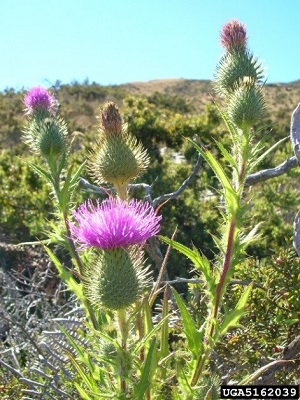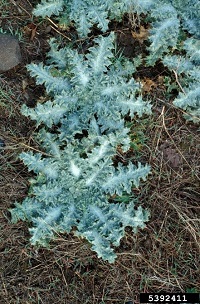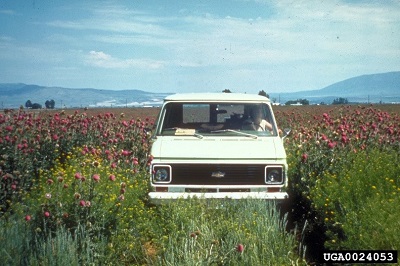Biennial thistle biology, ecology, and management- October 2015
Download this weed post on biennial thistles as a PDF
Introduction

Photo by Forest and Kim Starr, Bugwood.org
Land managers often have questions about managing large-statured, non-native biennial thistles. This group of plants includes bull thistle (Cirsium vulgare, photo right), musk thistle (Carduus nutans), plumeless thistle (Carduus acanthoides), and scotch thistle (Onopordum acanthium).
Biology and identification
Biennial thistles usually germinate and emerge in the summer and fall and overwinter as a rosette (photo below). In spring and summer of the second year, they bolt, flower, and produce seeds. Biennial thistles die by the end of summer their second year.
Habitat
Seedlings of biennial thistles establish on bare soils found in sparsely vegetated or disturbed sites and can become quite abundant in these types of habitat (photo below). Biennial thistles can germinate and grow in a wide range of environmental conditions such as pasture, range and forest lands along with roadsides, waste areas, ditch banks, stream banks, and grain fields.
Spread
Reproduction is only by seed, and seeds can be dispersed by human activities such as movement of hay and crop seeds, or by animals, water or wind. Despite these various vectors, most seeds fall relatively close to the parent plant.

Photo by John Randall, Bugwood.org
Impacts
The impact of biennial thistles on forage is twofold; they act as a physical barrier to livestock and compete with desired vegetation after disturbance. For example, in favorable conditions musk thistle can form dense stands of up to 150,000 plants/hectare. Dense stands can restrict livestock movement, and have been referred to as a “living barbed wire fence.” Livestock tend to avoid grazing near this species due to its numerous spines, causing a reduction in usable forage. In fact, researchers have found that one musk thistle plant per square meter decreases sheep weight by four pounds per animal. Since the vegetative parts of these plants are unpalatable to most livestock, biennial thistles tend to increase with overgrazing.

Photo by Norman Reese, Bugwood.org
Management priorities
As biennial thistle establishment is dependent on bare ground and disturbance, establishing a competitive stand of desired perennial vegetation should be the first management priority to reduce their prevalence over the long term. These goals may require revegetation or limiting of disturbance like overgrazing. Short term biennial thistle control can be accomplished using cultural, mechanical and chemical methods. Biennial thistles can be killed by mechanical means that sever the taproot below the soil surface. Hoeing or hand-pulling are useful tools in small patches, and tillage is effective in croplands. Mowing is not considered an effective control method as it does not kill the plant, and variation in flowering times within a population ensures some seed will be produced. Several herbicides are available for control if applied at the rosette stage, and there are also a few choices for use during the bolting and bud stages. For herbicide recommendations, see the "Field Guide for Managing Annual and Biennial Invasive Thistles in the Southwest."
For information about thistle identification, see our new publication, “Guide to exotic thistles of Montana and how to differentiate from native thistles”
